Rugby league
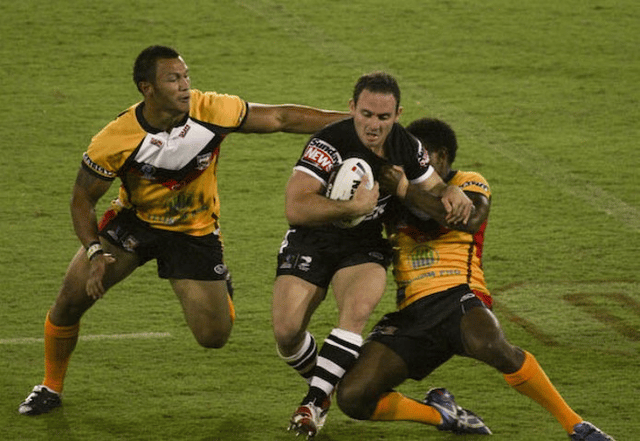
Rugby league

| Highest governing body | Rugby League International Federation |
|---|---|
| Nicknames | League, RL, Rugby XIII (used throughout Europe) League, footy, football (used throughout the Oceania regions) |
| First played | 7 September 1895, Yorkshire Northern England. (Post schism) |
| Characteristics | |
| Contact | Full contact |
| Team members | Thirteen |
| Mixed gender | Single |
| Type | Team sport, Outdoor |
| Equipment | Rugby League ball |
| Venue | Rugby league playing field |
Rugby league is a full-contact sport played by two teams of thirteen players on a rectangular field measuring 68m wide and 112-122m long.[1] One of the two codes of rugby, it originated in Northern England in 1895 as a split from the Rugby Football Union over the issue of payments to players.[2] Its rules progressively changed with the aim of producing a faster, more entertaining game for spectators.[3]
In rugby league, points are scored by carrying the ball and touching it to the ground beyond the opposing team's goal line; this is called a try, and is the primary method of scoring.[4] The opposing team attempts to stop the attacking side scoring points by tackling the player carrying the ball.[4] In addition to tries, points can be scored by kicking goals. After each try, the scoring team gains a free kick to try at goal with a conversion for further points.[4] Kicks at goal may also be awarded for penalties, and field goals can be attempted at any time.
The Super League and the National Rugby League (NRL) are the premier club competitions. Rugby league is played internationally, predominantly by European, Australasian and Pacific Island countries, and is governed by the Rugby League International Federation. The first Rugby League World Cup was held in France in 1954; the current holders are Australia.[11]
| Highest governing body | Rugby League International Federation |
|---|---|
| Nicknames | League, RL, Rugby XIII (used throughout Europe) League, footy, football (used throughout the Oceania regions) |
| First played | 7 September 1895, Yorkshire Northern England. (Post schism) |
| Characteristics | |
| Contact | Full contact |
| Team members | Thirteen |
| Mixed gender | Single |
| Type | Team sport, Outdoor |
| Equipment | Rugby League ball |
| Venue | Rugby league playing field |
Etymology
Rugby league football takes its name from the bodies that split to create a new form of rugby, distinct from that run by the Rugby Football Unions, in Britain, Australia and New Zealand between 1895 and 1908.
The first of these, the Northern Rugby Football Union, was established in 1895 as a breakaway faction of England's Rugby Football Union (RFU). Both organisations played the game under the same rules at first, although the Northern Union began to modify rules almost immediately, thus creating a new faster, stronger paced form of rugby football. Similar breakaway factions split from RFU-affiliated unions in Australia and New Zealand in 1907 and 1908, renaming themselves "rugby football leagues" and introducing Northern Union rules.[12] In 1922, the Northern Union also changed its name to the Rugby Football League[13] and thus over time the sport itself became known as "rugby league" football.
History
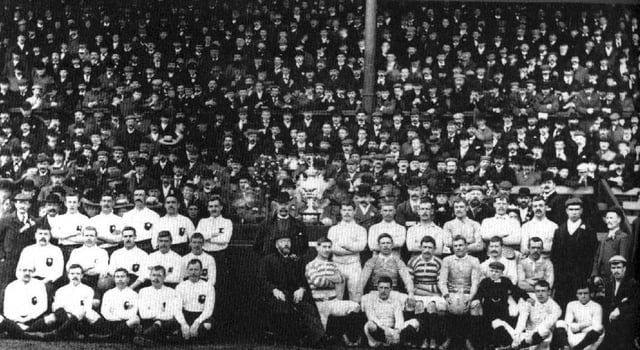
The first ever Challenge Cup Final, 1897: Batley (left) vs St Helens (right)
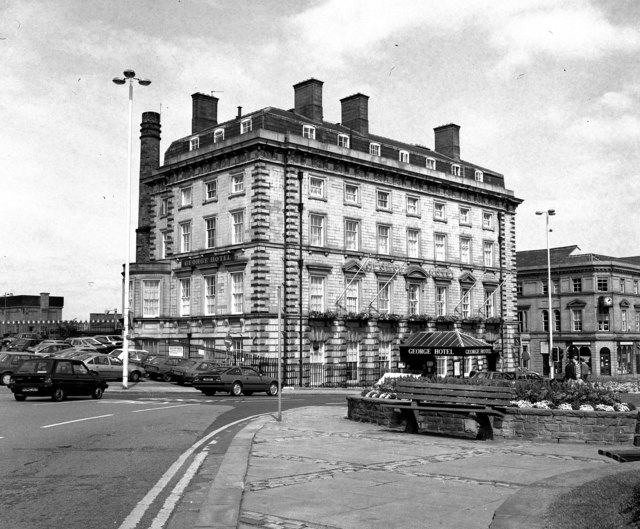
George Hotel, Huddersfield
In 1895, a schism in Rugby football resulted in the formation of the Northern Rugby Football Union (NRFU).[14] Although many factors played a part in the split, including the success of working class northern teams, the main division was caused by the RFU decision to enforce the amateur principle of the sport, preventing "broken time payments" to players who had taken time off work to play rugby. Northern teams typically had more working class players (coal miners, mill workers etc.) who could not afford to play without this compensation, in contrast to affluent southern teams who had other sources of income to sustain the amateur principle.[2] In 1895, a decree by the RFU banning the playing of rugby at grounds where entrance fees were charged led to twenty-two clubs (including Stockport, who negotiated by telephone) meeting at the George Hotel, Huddersfield on 29 August 1895 and forming the "Northern Rugby Football Union".[15] Within fifteen years of that first meeting in Huddersfield, more than 200 RFU clubs had left to join the rugby revolution.
A similar schism to that which occurred in England took place in Sydney, Australia. There, on 8 August 1907 the New South Wales Rugby Football League was founded at Bateman's Hotel in George Street.[19] Rugby league then went on to displace rugby union as the primary football code in New South Wales and Queensland.[20]
On 5 May 1954 over 100,000 (official figure 102,569) spectators watched the 1953–54 Challenge Cup Final at Odsal Stadium, Bradford, England, setting a new record for attendance at a rugby football match of either code.[19] Also in 1954 the Rugby League World Cup, the first for either code of rugby, was formed at the instigation of the French. In 1966, the International Board introduced a rule that a team in possession was allowed three play-the-balls and on the fourth tackle a scrum was to be formed. This was increased to six tackles in 1972 and in 1983 the scrum was replaced by a handover.[21] 1967 saw the first professional Sunday matches of rugby league played.
The first sponsors, Joshua Tetley and John Player, entered the game for the 1971–72 Northern Rugby Football League season. Television would have an enormous impact on the sport of rugby league in the 1990s when Rupert Murdoch's News Corporation sought worldwide broadcasting rights and refused to take no for an answer. The media giant's "Super League" movement saw big changes for the traditional administrators of the game. In Europe, it resulted in a move from a winter sport to a summer one as the new Super League competition tried to expand its market. In Australasia, the Super League war resulted in long and costly legal battles and changing loyalties, causing significant damage to the code in an extremely competitive sporting market. In 1997 two competitions were run alongside each other in Australia, after which a peace deal in the form of the National Rugby League was formed. The NRL has since become recognised as the sport's flagship competition and since that time has set record TV ratings and crowd figures.[22]
Rules
Laws of the game
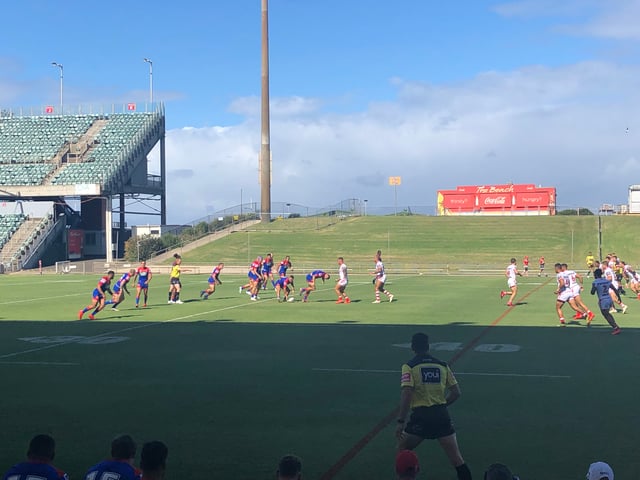
A typical game of rugby league being played.
The objective in rugby league is to score more points through tries, goals (also known as conversions) and field goals (also known as drop goals) than the opposition within the 80 minutes of play. If after two halves of play, each consisting of forty minutes, the two teams are drawing, a draw may be declared, or the game may enter extra time under the golden point rule, depending on the relevant competition's format.
The try is the most common form of scoring,[23] and a team will usually attempt to score one by running and kicking the ball further upfield or passing from player-to-player in order to manoeuvre around the opposition's defence. A try involves touching the ball to the ground on or beyond the defending team's goal-line and is worth four points. A goal is worth two points and may be gained from a conversion or a penalty. A field goal, or drop goal, is only worth one point and is gained by dropping and then kicking the ball on the half volley between the uprights in open play.
Field position is crucial in rugby league,[24] achieved by running with or kicking the ball. Passing in rugby league may only be in a backward or sideways direction. Teammates, therefore, have to remain on-side by not moving ahead of the player with the ball. However the ball may be kicked ahead for teammates, but again, if they are in front of the kicker when the ball is kicked, they are deemed off-side. Tackling is a key component of rugby league play. Only the player holding the ball may be tackled. A tackle is complete, for example, when the player is held by one or more opposing players in such a manner that he can make no further progress and cannot part with the ball, or when the player is held by one or more opposing players and the ball or the hand or arm holding the ball comes into contact with the ground.[25] An attacking team gets a maximum of six tackles to progress up the field before possession is changed over. Once the tackle is completed, the ball-carrier must be allowed to get to his feet to 'play-the-ball'. Ball control is also important in rugby league, as a fumble of the ball on the ground forces a handover, unless the ball is fumbled backwards. The ball can also be turned over by going over the sideline.
Comparison with rugby union
The comparison with rugby union is possible because of the games' similarities and shared origins; however, they remain two distinctly different sports.
Both sports have the same fundamental rules, are played for 80 minutes and feature an oval-shaped ball and H-shaped goals. Both have rules that the ball cannot be passed forward, and dropping it forwards leads to a scrum. Both use tries as the central scoring method and conversions, penalty goals and drop goals as additional scoring methods. However, there are differences in how many points each method is worth.
One of the main differences is the rules of possession,[26] When the ball goes into touch, possession in rugby union is contested through a line-out, while in rugby league a scrum restarts play. The lesser focus on contesting possession means that play stops less frequently in rugby league,[27] with the ball typically in play for 50 out of the 80 minutes compared to around 35 for professional rugby union.[28] Other differences include that there are fewer players in rugby league (13 compared to 15),[29][30] different rules for tackling and that a rugby league pitch is shorter in length. Rugby union has more detailed rules than rugby league[31][32] and has changed less since the 1895 schism.[33]
The inherent similarities between rugby league and rugby union have at times led to the possibility of a merger of the two variants[34] and experimental hybrid games have been played that use a mix of the two sports' rules.[35] Rugby league historian Tony Collins has written that since turning professional in the mid-1990s, rugby union has increasingly borrowed techniques and tactics from rugby league.[36][37]
Positions
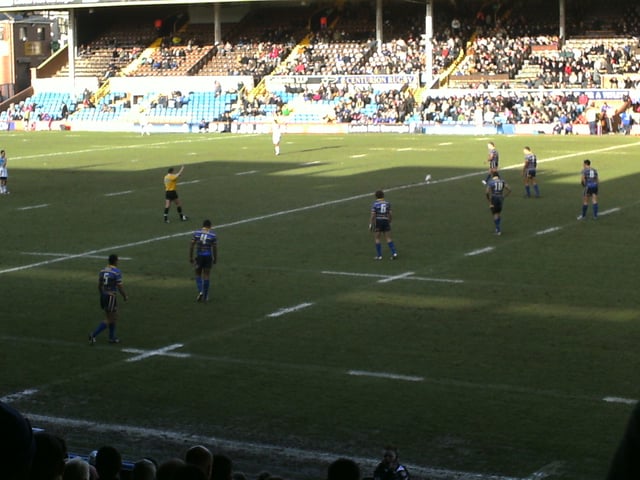
Leeds playing at the 2008 Boxing Day friendly against Wakefield Trinity at Headingley
Players on the pitch are divided into forwards and backs, although the game's rules apply to all players the same way. Each position has a designated number to identify himself from other players. These numbers help to identify which position a person is playing. The system of numbering players is different depending on which country the match is played in. In Australia and New Zealand, each player is usually given a number corresponding to their playing position on the field. However, since 1996 European teams have been able to grant players specific squad numbers, which they keep without regard to the position they play, similarly to association football.[38]
Substitutes (generally referred to as "the bench") are allowed in the sport, and are typically used when a player gets tired or injured, although they can also be used tactically. Each team is currently allowed four substitutes, and in Australia and New Zealand, these players occupy shirt numbers 14 to 22.[39] There are no limitations on which players must occupy these interchangeable slots. Generally, twelve interchanges are allowed in any game from each team, although in the National Rugby League, this was reduced to ten prior to the 2008 season[40] and further reduced to eight prior to the 2016 season. If a team has to interchange a player due to the blood bin rule or due to injury, and this was the result of misconduct from the opposing team, the compromised team does not have to use one of its allocated interchanges to take the player in question off the field.
Backs
The backs are generally smaller, faster and more agile than the forwards. They are often the most creative and evasive players on the field, relying on running, kicking and handling skills, as well as tactics and set plays, to break the defensive line, instead of brute force. Generally forwards do the majority of the work (hit-ups/tackling).
The title of fullback (numbered 1) comes from the fullback's defensive position where the player drops out of the defensive line to cover the rear from kicks and runners breaking the line. They therefore usually are good ball catchers and clinical tacklers. In attack, the fullback will typically make runs into the attack or support a runner in anticipation of a pass out of the tackle. Fullbacks can play a role in attack similar to a halfback or five-eighth and the fact that the fullback does not have to defend in the first defensive line means that a coach can keep a playmaker from the tackling responsibilities of the first line whilst allowing them to retain their attacking role.
The wingers (numbered 2 and 5) are normally the fastest players in a team and play on the far left and right fringes of the field (the wings). Their main task is to receive passes and score tries. The wingers also drop back on the last tackle to cover the left and right sides of the field for kicks while the fullback covers the middle.
The centres (numbered 3 and 4) are positioned one in from the wings and together complete what is known as the three-quarter line. Usually the best mixture of power and vision, their main role is to try to create attacking opportunities for their team and defend against those of the opposition. Along with the wingers, the centres score plenty of tries throughout a season. They usually have a large build and therefore can often play in the second row forwards.
Usually, the stand-off/five-eighth and scrum-half/half-back are a team's creative unit or 'playmakers'. During the interactions between a team's 'key' players (five-eighth, half-back, fullback, lock forward, and hooker), the five-eighth and half-back will usually be involved in most passing moves. These two positions are commonly called the "halves".
The stand-off half, or five-eighth (numbered 6): There is not much difference between the stand-off half and the scrum half (halfback), in that both players may operate in front of the pack during 'forward play' (as prime receiver [7] and shadow receiver [6], one on each side of the ruck, or both on same side of the ruck), and both players may operate in front of the backs during 'back play' (as prime pivot [6] and shadow pivot [7], one on each side of the pack, or both on same side of the ruck / pack). The Five-Eighth position is named with regard to the distance that the player stands in relevance to the team.
The halfback (numbered 7): There is not much difference between the halfback and the five-eighth, in that both players may operate in front of the pack during 'forward play' (as prime receiver [7] and shadow receiver [6], one on each side of the ruck, or both on same side of the ruck). Both players may operate in front of the backs during 'back play' (as prime pivot [6] and shadow pivot [7], one on each side of the ruck/pack, or both on same side of the ruck/pack). The halfback position is named with regard to halfway between the fullback and the forwards.
Forwards
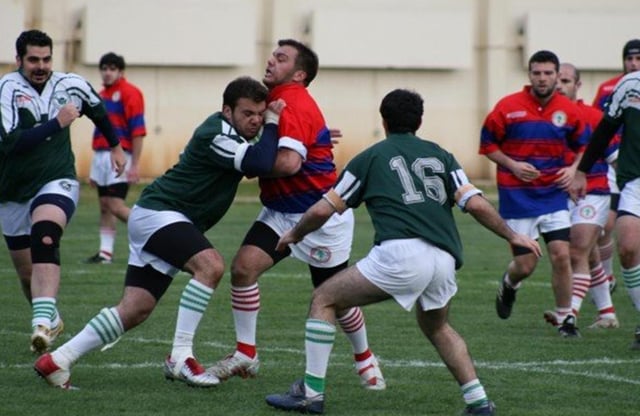
Rugby league is noted for its hard physical play
The forwards' two responsibilities can be broken into "normal play" and "scrum play". For information on a forward's role in the scrum see rugby league scrummage. Forward positions are traditionally named after the player's position in the scrum yet are equal with respect to "normal play" with the exception of the hooker. Forward positions are traditionally assigned as follows:
The props or front-row forwards (numbered 8 and 10) are normally the largest players on field. They are positioned in the centre of the line. The prop will be an "enforcer", dissuading the opposition from attacking the centre of the defensive line and, in attack, will give the team momentum by taking the ball up to the defence aggressively.
The hooker (numbered 9) is most likely to play the role of dummy half. In defence the hooker usually defends in the middle of the line against the opposition's props and second-rowers. The hooker will be responsible for organising the defence in the middle of the field. In attack as dummy-half this player is responsible for starting the play from every play-the-ball by either passing the ball to the right player, or, at opportune moments, running from dummy-half. It is vital that the hooker can pass very well. Traditionally, hookers "hooked" the ball in the scrum. Hookers also make probably more tackles than any other player on the field. The hooker is always involved in the play and needs to be very fit. They need to have a very good knowledge of the game and the players around them.
The second row forwards (numbered 11 and 12) The modern day second row is very similar to a centre and is expected to be faster, more mobile and have more skills than the prop and will play amongst the three-quarters, providing strength in attack and defence when the ball is passed out to the wings. Good second-rowers combine the skills and responsibilities of props and centres in the course of the game.
The Loose forward or Lock (numbered 13) is the only forward in the third (last) row of the scrum. They are usually among the fittest players on the field, covering the entire field on both attacking and defending duties. Typically they are big ball-runners who can occasionally slot in as a passing link or kick option; it is not uncommon for locks to have the skills of a five-eighth and to play a similar role in the team.
Rugby league worldwide
Rugby league is played in over 70 nations throughout the world. Seven countries — Australia, Canada, England, France, New Zealand, Papua New Guinea and Wales — have teams that play at a professional level, while the rest are completely amateur. 36 national teams are ranked by the RLIF and a further 32 are officially recognized and unranked.[41] The strongest rugby league nations are Australia, England and New Zealand.
World Cup
The Rugby League World Cup is the highest form of representative rugby league and currently features 14 teams. Those which have contested World Cups are; Australia, New Zealand, England, France, Fiji, Wales, Papua New Guinea, Samoa, Ireland, USA, Scotland, Italy, Tonga, Cook Islands, Lebanon, Russia and South Africa. The current World Champions are Australia, who won the 2017 Rugby League World Cup. The next Rugby League World Cup will be held in October and November 2021 and hosted by England. This will be the first time that the Men’s, Women’s and Wheelchair competitions will be staged together.[42]
Oceania and South Pacific
The Asia-Pacific Rugby League Confederation's purpose is to spread the sport of rugby league throughout their region along with other governing bodies such as the ARL and NZRL.[43] Since rugby league was introduced to Australia in 1908, it has become the largest television sport and 3rd most attended sport in Australia.[44] Neighbouring Papua New Guinea is one of two countries to have rugby league as its national sport (with Cook Islands).[6][7] Australia's elite club competition also features a team from Auckland, New Zealand's biggest city. Rugby league is the dominant winter sport in the eastern Australian states of New South Wales and Queensland.[45] The game is also among the predominant sports of Tonga[46] and is played in other Pacific nations such as Samoa and Fiji. In Australia, and indeed the rest of the region, the annual State of Origin series ranks among the most popular sporting events.[47][48]
Europe
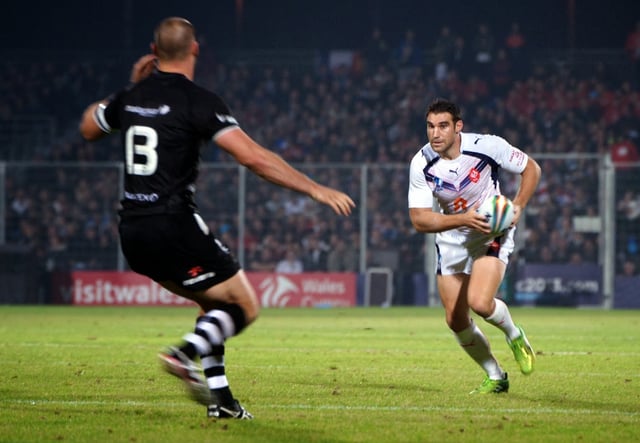
France vs New Zealand in the 2013 Rugby League World Cup at Parc des Sports (Avignon).
The Rugby League European Federation are responsible for developing rugby league in Europe and the Northern Hemisphere,[49]
In England, rugby league has traditionally been associated with the northern counties of Yorkshire, Lancashire and Cumbria where the game originated, especially in towns along the M62 corridor.[8] Its popularity has also increased elsewhere.[50][51][52] As of 2019, only two of the twelve Super League teams are based outside of these traditional counties: London Broncos and Catalans Dragons (Perpignan). Two other teams from outside the United Kingdom, the Toronto Wolfpack and Toulouse Olympique, also compete in the English Rugby League system. Both teams will play in the Rugby League Championship in 2018.
Super League average attendances are in the 8,000 to 9,500 range. The average Super League match attendance in 2014 was 8,365.[53] Ranked the eighth most popular sport in the UK overall,[54] rugby league is the 27th most popular participation sport in England according to figures released by Sport England; the total number of rugby league participants in England aged 16 and over was 44,900 in 2017.[55] This is a 39% drop from 10 years ago.[55] While the sport is largely concentrated in the north of England there have been complaints about its lack of profile in the British media. On the eve of the 2017 Rugby League World Cup Final where England would face Australia, English amateur rugby league coach Ben Dawson stated, “we’re in the final of a World Cup. First time in more than 30 years and there's no coverage anywhere.”[56]
France first played rugby league as late as 1934, where in the five years prior to the Second World War, the sport's popularity increased as Frenchmen became disenchanted with the state of French rugby union in the 1930s.[57] However, after the Allied Forces were defeated by Germany in June 1940, the Vichy regime in the south seized assets belonging to rugby league authorities and clubs and banned the sport for its association with the left-wing Popular Front government that had governed France before the war.[57] The sport was unbanned after the Liberation of Paris in August 1944 and the collapse of the Vichy regime, although it was still actively marginalised by the French authorities until the 1990s.[57] Despite this, the national side appeared in the finals of the 1954 and 1968 World Cups, and the country hosted the 1954 event.[58][59] In 1996, a French team, Paris Saint-Germain was one of eleven teams which formed the new Super League, although the club was dissolved in 1997.[60] In 2006, the Super League admitted the Catalans Dragons, a team from Perpignan in the southern Languedoc-Roussillon region.[61] They have subsequently reached the 2007 Challenge Cup Final and made the playoffs of the 2008 Super League XIII season. The success of the Dragons in Super League has initiated a renaissance in French rugby league, with new-found enthusiasm for the sport in the south of the country where most of the Elite One Championship teams are based. In other parts of Europe, the game is played at semi-professional and amateur level.
North America
The Toronto Wolfpack are currently North America's only active professional Rugby League team, competing in the English Rugby League system. The Wolfpack won the 2017 Kingstone Press League 1 in their inaugural season and earned promotion to the 2018 Rugby League Championship. The Wolfpack play their home games at Lamport Stadium in Toronto.[62] Beginning in 2020, however, the English Hemel Stags will be relocated to Ottawa, where their home field will be TD Place Stadium.[63]
Other countries
The early 21st century has seen other countries take up the game and compete in international rugby league with the Rugby League European Federation and Asia-Pacific Rugby League Confederation expanding the game to new areas such as Canada, Ghana, Philippines, Czech Republic, Germany, Sweden, Norway, Spain, Hungary, Turkey, Thailand, Chile, Brazil and Argentina to name a few.[64][65][66]
Domestic professional competitions
The two most prominent full-time professional leagues are the Australasian National Rugby League and the Super League and to a lesser extent the semi professional French Elite One Championship and Elite Two Championship. Domestic leagues, with some full-time exceptions, exist at a semi-professional level below the NRL and Super League, in Australia the Queensland Cup (which includes a team from Papua New Guinea) and NSW Cup, which provides players to various NRL teams.
In the United Kingdom, below the Super League, are the Championship and League 1. The UK professional system includes 2 Welsh teams, 2 French and 1 Canadian team).
The Papua New Guinea National Rugby League operates as a semi-professional competition and enjoys nationwide media coverage, being the national sport of the country.
Attendances
International
The top five attendances for rugby league test matches (International) are:
| Game | Date | Result | Venue | City | Crowd |
|---|---|---|---|---|---|
| 2013 World Cup Final | 30 November 2013 | Australia def. New Zealand 34–2 | Old Trafford | Manchester | 74,468 |
| 1992 World Cup Final | 24 October 1992 | Australia def. Great Britain 10–6 | Wembley Stadium | London | 73,631 |
| 1932 Ashes series, Game 1 | 6 June 1932 | England def. Australia 8–6 | Sydney Cricket Ground | Sydney | 70,204 |
| 1962 Ashes series, Game 1 | 9 June 1962 | Great Britain def. Australia 31–12 | Sydney Cricket Ground | Sydney | 70,174 |
| 1958 Ashes series, Game 1 | 14 June 1958 | Australia def. Great Britain 25–8 | Sydney Cricket Ground | Sydney | 68,777 |
Domestic
The top five attendances for domestic based rugby league matches are:
| Game | Date | Result | Venue | City | Crowd |
|---|---|---|---|---|---|
| 1999 NRL Grand Final | 26 September 1999 | Melbourne def. St George Illawarra 20–18 | Stadium Australia | Sydney | 107,999 |
| 1999 NRL season Round 1 | 6 March 1999 | Newcastle Knights def. Manly-Warringah Sea Eagles 41–18 Parramatta Eels def. St George Illawarra Dragons 20–10 | Stadium Australia | Sydney | 104,583* |
| 1954 Challenge Cup Final replay | 5 May 1954 | Warrington def. Halifax 8–4 | Odsal Stadium | Bradford | 102,569** |
| 1985 Challenge Cup Final | 4 May 1985 | Wigan def. Hull F.C. 28–24 | Wembley Stadium | London | 99,801 |
| 1966 Challenge Cup Final | 21 May 1966 | St. Helens def. Wigan 21–2 | Wembley Stadium | London | 98,536 |
- NRL double header played to open Round 1 of the 1999 NRL season. Figure shown is the total attendance which is officially counted for both games.[67][68]** The official attendance of the 1954 Challenge Cup Final replay was 102,569. Unofficial estimates put the attendance as high as 150,000, Bradford Police confirming 120,000.
See also
History of rugby league
List of rugby league terms
Playing rugby league
List of international rugby league teams
Rugby league nines
Rugby league sevens
Tag Rugby (OzTag) – a completely non-contact version of rugby league
Touch football – an almost non-contact version
League tag – A semi-contact version of Rugby League
Comparison of rugby league and rugby union
Geography of rugby league